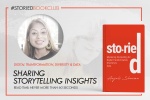Your Data Storytelling is very dependent on the Data Points you choose for the correct story to shape up.
Brian Wansink Professor of Marketing and the Director of the Cornell Food and Brand Lab. Author of Slim By Design and Mindless Eating is famous for the popcorn study. This popcorn study is a great way to elaborate this point.
Here is what the Popcorn Study was all about.
*One Saturday in 2000, some unsuspecting moviegoers showed up at a suburban theater in Chicago to catch a 1:05 p.m. matinee of Mel Gibson’s action flick Payback. They were handed a soft drink and a free bucket of popcorn and were asked to stick around after the movie to answer a few questions about the concession stand. These movie fans were unwitting participants in a study of irrational eating behavior.
There was something unusual about the popcorn they received. It was wretched. In fact, it had been carefully engineered to be wretched.
Some of them got their free popcorn in a medium-size bucket, and others got a large bucket. Every person got a bucket so there’d be no need to share. The researchers responsible for the study were interested in a simple question: Would the people with bigger buckets eat more?
Both buckets were so big that none of the moviegoers could finish their individual portions. So the actual research question was a bit more specific: Would somebody with a larger inexhaustible supply of popcorn eat more than someone with a smaller inexhaustible supply?
The researchers weighed the buckets before and after the movie, so they were able to measure precisely how much popcorn each person ate. The results were stunning: People with the large buckets ate 53 percent more popcorn than people with the medium size. So, clearly People eat more when you give them a bigger container.
What interests me most about this study is not the finding but imagine that a data analyst looked at this study and put together a graph with two data points, the number of people and how much they ate, with no mention of bucket sizes. Upon looking at the data you would quickly jump to the conclusion that some people simply ate too much and you would perhaps want to think about ways to motivate people to adopt healthy eating habits.
But in fact there is a much more simple solution available at hand which is to reduce the bucket sizes.
In summary you may have a way to obtain data but knowing the correct data points to use and interpret will give you the insights you need for the best business outcomes.
Narrative’ Data Storytelling Workshop is designed to help business professionals learn how to tell a story hidden in Data for Better Business Outcomes.
* Source : Switch: How to Change Things When Change Is Hard by Chip Heath and Dan Heath
"I attended your story telling course some time back. And I've enjoyed keeping up my knowledge with your blog. You may not have realised however, that the Whole of Government is implementing Internet Seperation. Hence I'm not able to access the links to read your articles. Could I suggest including a QR code in your emails so that I can use my mobile to scan it and gain immediate access to the article? It would be most helpful"










